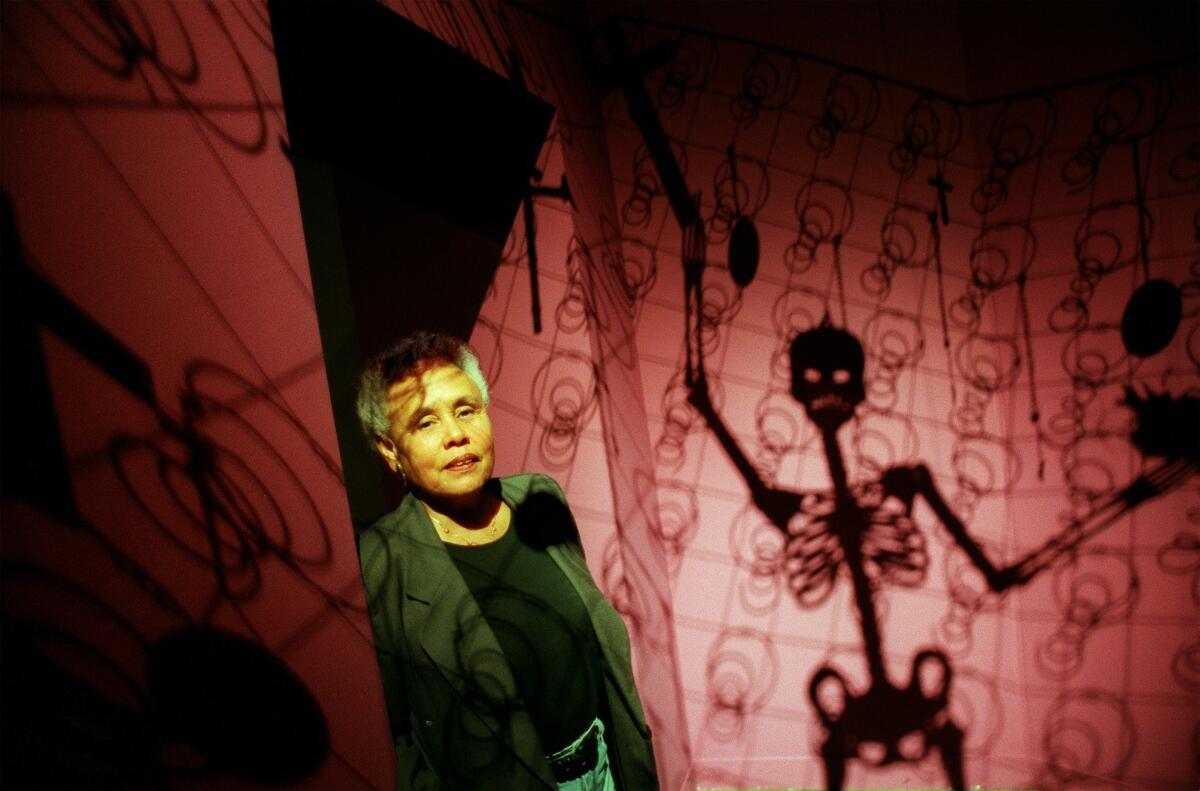Column: Betye Saar’s art on race couldn’t be timelier. So why aren’t more museums showing her work?
It’s not for nothing that Betye Saar’s traveling museum show is called “Still Tickin’.”
This week the 89-year-old artist wraps up her first museum solo exhibition in Europe at the Netherlands’ Museum Het Domein. That show lands at the Scottsdale Museum of Contemporary Art in Arizona in early 2016 — but isn’t coming to Los Angeles, unfortunate given that Saar is a born-and-raised Angelena.
Still, Saar will have a solo show next fall at her Culver City gallery, Roberts & Tilton, to celebrate her 90th birthday. To mark the occasion, the gallery is also prepping a catalog raisonné of her work.
Saar is part of a cohort of important African American artists that includes John Outterbridge, Noah Purifoy and David Hammons, who have been highly influential to younger generations in California and beyond.
She got her start in the 1960s as a print-maker before turning to assemblage and installation as her principal medium, using objects she turns up at thrift shops and garage sales: clocks, bird cages, dolls, chairs, scales, bits of clothing and kitsch figurines.
But she is best known for the ways in which she has employed racially charged black collectibles in her pieces, from mammy figures to thick-lipped pickaninnies eating watermelon — images that distort and dehumanize the black figure.
“It’s like they abolished slavery but they kept black people in the kitchen as mammy jars,” Saar says.
One of her seminal works, “The Liberation of Aunt Jemima,” completed in 1972 (and now in the collection of the Berkeley Art Museum), shows the popular food icon armed with a rifle in addition to a broom.
“I wanted to empower her,” Saar says. “I wanted to make her a warrior. I wanted people to know that black people wouldn’t be enslaved by that.”
The artist’s work figures in the collection of numerous museums — from the L.A. County Museum of Art and the Museum of Contemporary Art in Los Angeles to the Museum of Modern Art and the Metropolitan Museum of Art in New York. And she was in eight Pacific Standard Time shows in 2010, the Getty-funded series that explored the art of Southern California during the post-War era.
In recent years, though, Saar has been overlooked by L.A.’s major art museums. (Something I discussed with art historian Steven Nelson of UCLA back in July.) The last solo museum show she had in Los Angeles was “Cage” in 2011 at the California African American Museum (CAAM), which featured a series of new works. Before that, her other museum solo exhibitions — at CAAM, MOCA and the Santa Monica Museum of Art — date to the mid- and early 1990s.
No full-blown retrospective beyond the show in Scottsdale is forthcoming — and there are no plans for that show to travel to California.

Betye Saar, in 1997, standing amid her piece ‘Saints Sinners Shamans Seeking Solitude. Sanctuary Awaits,’ at the California African-American Museum.
This is a shame. Saar has been a presence in the L.A. art world for more than half a century. Her work is in major museum collections. And it addresses questions of race and image-making that couldn’t be more current.
In late September, I went to visit the artist in her sunny Laurel Canyon studio. Age has slowed her a bit.
“Things ache a bit more,” she explains as she weaves through empty bird cages and boxes full of vintage tchotchkes, bits that will end up in a series of assemblages-in-progress that sit on a wide wooden table. But she remains bubbly and funny and full of stories about the Hollywood Hills back in hippie days.
“I guess it’s always a problem to get recognized in your hometown,” she reflects.
“But they can’t wait and wait because then I’ll die and it’ll cost big bucks,” she adds with a laugh. “Then they will pay for their hesitation.”
“Betye Saar: Still Tickin’” is on view at the Museum Het Domein in Sittard, Netherlands, through Sunday. Kapittelstraat 6, 6131 ER Sittard, Netherlands, hetdomein.nl. The show opens at the Scottsdale Museum of Contemporary Art on Jan. 30.
Find me on Twitter @cmonstah.
More to Read
The biggest entertainment stories
Get our big stories about Hollywood, film, television, music, arts, culture and more right in your inbox as soon as they publish.
You may occasionally receive promotional content from the Los Angeles Times.











